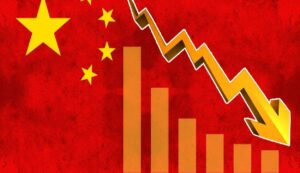China’s economy is facing recession after the pandemic
Beijing: Growth in China’s economy has slowed from 6.5% before the epidemic to 4.6% at now, and there are worries that even that figure is greatly exaggerated. Living standards are still significantly lower than in industrialized countries due to the economy’s continued stagnation, which emphasizes the country’s economic difficulties, according to the Asia Times.

The nation’s deteriorating total factor productivity (TFP), which gauges how effectively inputs like labor and capital are utilized to create output, is one of the main causes of this slump. Although official data indicates that TFP has decreased over the last 15 years, this assertion is still up for question. In any case, most people believe that productivity growth has slowed considerably from previous years.
One of the main causes of the slowdown, according to economist Paul Krugman, is a move toward real estate. China started investing heavily in the low-productivity real estate sector during the global financial crisis of 2008, which reduced total output. Furthermore, a 2022 study brought to light more general structural problems with China’s economy, such as inefficient capital allocation and an excessive dependence on a resource-extraction-driven development model. The consequences of trade tensions, COVID-19 interruptions, and the Chinese government’s aggressive industrial strategies have exacerbated these systemic issues, which were previously there before the epidemic.
In retrospect, previous projections of China’s economic future seem too rosy. In his 2016 book China’s Economy: What Everyone Needs to Know®, Arthur Kroeber outlined China’s successful shift from a resource-based economy to one driven by technology innovation and productivity. This optimism has subsequently diminished, however, since the nation has found it difficult to sustain the productivity growth required for long-term prosperity. Although Kroeber admitted that China has economic difficulties, his aspirations for a change to efficiency-driven development now seem less realistic. Although Kroeber’s observations on urbanization, fiscal federalism, and real estate are valuable, his optimism for China’s future is no longer consistent with the country’s actual economic trajectory.
China is approaching the limits of its economic potential, which is a major contributing factor to the downturn. While nations like South Korea, Taiwan, and Japan were able to effectively shift to high-income economies by emphasizing productivity and technical breakthroughs, China’s development has slowed similarly to other middle-income nations like Thailand. China’s TFP has been declining since 2011, with some studies even indicating negative growth. Acquiring cutting-edge technology has become more difficult as China moves closer to the technical frontier because businesses everywhere are increasingly cautious about protecting their inventions.
Another reason for the decline in productivity in China is the country’s demography. China had a “demographic dividend,” or a large, youthful labor population with comparatively few dependents, for many years. However, since the country’s working-age population started to fall in 2010, that edge has begun to wane. China is not an exception to the rule that aging populations are often associated with slower productivity growth. Maintaining productivity levels is a major issue for the economy as a result of an older population and fewer individuals joining the workforce.
China’s productivity has traditionally increased via urbanization, which transferred people from low-productivity agricultural employment to higher-productivity urban industrial ones. However, this trend is waning. Although urbanization contributed to China’s decades-long fast economic expansion, analysts refer to 2010 as the “Lewis turning point,” when the amount of excess labor in agriculture started to decline. Furthermore, the advantages of urbanization have been further curtailed by China’s hukou system, which limits internal mobility. Productivity growth has slowed as a result of these demographic and structural shifts, and the technology adoption, urbanization, and population growth tailwinds are no longer powerful enough to drive the economy ahead at the same rate.
China’s research and development (R&D) industry is another major obstacle to increasing productivity. Despite China’s recent emphasis on research and development, studies have shown that state-owned enterprises (SOEs) generally exhibit much poorer R&D productivity than private or foreign-owned businesses. According to research by Konig et al. (2021), R&D expenditures have helped increase productivity, but their effects have been limited because of problems including resource misallocation and the incorrect designation of costs as “R&D.” Furthermore, there are questions about the quality of Chinese academic research and its leadership in the world, despite the fact that China has grown its university research sector and raised its research expenditures. There have been reports of nepotism, data fabrication, and plagiarism in the nation’s scientific community, which compromises the efficacy of research and lowers its output.
China’s productivity has been impacted by the limitations it faces in its export market. According to economic theory, international rivalry encourages innovation and boosts productivity by enforcing “export discipline.” However, due to trade disputes and market saturation, the demand for Chinese products has decreased since the 2008 financial crisis. The rise in exports to the European Union hasn’t offset the decrease in shipments to other markets. Furthermore, while China’s exports to developing countries have increased, their buying power is far smaller. Consequently, the advantages of export-driven development have diminished as China’s proportion of world exports has been declining. According to the Asia Times, the country’s long-term productivity development is threatened by this change from an export-led economy to one that prioritizes domestic investment.
Another factor contributing to China’s productivity issues is its low rates of consumption. China’s economy is still primarily focused on investment, in contrast to the United States, where consumption propels economic growth. In the United States, household consumption makes up over 80% of GDP, whereas in China, it only makes up 39%. As a consequence, businesses are less motivated to develop and distinguish their goods. China finds it more difficult to create new, high-quality items that may drive productivity development as a result of the low customer demand. Additionally, China’s policies have unintentionally hindered productivity by favoring investment over consumption.
Productivity has also been hampered by the nation’s strategy for maintaining economic stability. China used significant state-controlled bank lending between 2008 and 2016 to avert recessions, particularly in the real estate industry. Although this tactic contributed to economic stability, it also strengthened state-owned businesses and low-productivity sectors like real estate. Funds were disbursed quickly during this time, which resulted in ineffective initiatives and a dependence on industries with slow productivity development. Despite being successful in preventing recessions, these policies have made China’s economy heavily reliant on sectors with slow rates of productivity development.
President Xi Jinping has launched programs like Made in China 2025, which seeks to strengthen the country’s semiconductor sector and lessen its need for foreign technology, in an effort to solve these issues. It is unclear nonetheless whether these tactics will be effective in reversing the productivity decline. Xi has adopted a more assertive stance in the last three years, focusing on sectors he considers unfavorable, including consumer internet, banking, video games, entertainment, and real estate. His goal is to reroute resources, including cash and expertise, to sectors that he believes are more suited to China’s long-term economic objectives.
Xi’s approach differs from conventional industrial strategies, which usually concentrate on assisting prosperous industries. Rather, he is trying to demolish industries that he believes would harm the future of the nation. Companies that were formerly seen to be the foundation of China’s innovation, such as Alibaba, Tencent, and Baidu, are now being scrutinized, according to the Asia Times.
This change has sparked worries about how these rules may affect entrepreneurship. If the government can abruptly alter its goals or take over profitable businesses, entrepreneurs could be hesitant to launch new projects, which would create an environment of risk and uncertainty. The long-term impacts on innovation and entrepreneurship are yet unknown, even if refocusing resources into desired areas may initially be successful in redirecting talent.
Significant obstacles stand in the way of China’s attempts to address its productivity issues. Even while the government keeps enacting measures to support certain industries, the larger structural problems—such as changing demographics, ineffective R&D, and dwindling export demand—remain. Many academics have expressed doubts about China’s capacity to overcome its present economic stagnation, raising doubts about whether Xi Jinping’s industrial policies will successfully solve these issues and resume productivity growth.





